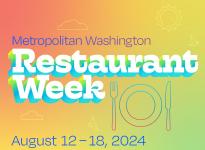You are here
News
July 25, 2024
Press Release | FOR IMMEDIATE RELEASE
Contact:
Avery Meetre, LRA PR
avery@lindarothpr.com
202-369-4954
RAMW Highlights Metropolitan Washington Summer Restaurant Week Offerings
Restaurant Week website now live to view participating restaurants + make reservations
Washington, DC (July 25, 2024)—Restaurant Association Metropolitan Washington (RAMW) announced today the roster of...
July 21, 2024
Press Release | Washington, DC (July 21, 2024)—Restaurant industry professionals and their allies gathered tonight at the Walter E. Washington Convention Center for the 42nd Annual RAMMYS Awards Gala as Restaurant Association Metropolitan Washington (RAMW) announced winners and a range of special distinctions, celebrating excellence in long-standing categories that range from individual professional honors...
June 18, 2024
Press Release | Carlos Rosario International Public Charter School Named The 2024 RAMMYS Joan Hisaoka Allied Member of the Year
Inaugural RAMMYS Honors Event also recognized Kathy E. Hollinger with the 2024 Duke Zeibert Capital Achievement Award and six DMV dining destinations with Honorary Milestone Awards
Washington, DC (June 18, 2024)—Restaurant industry professionals and their allies gathered tonight...
May 29, 2024
Press Release | FOR IMMEDIATE RELEASE
Contact:
Avery Meetre, LRA PR
avery@lindarothpr.com
202-369-4954
8/12 - 8/18: Metropolitan Washington Summer Restaurant Week
WHAT: Summer Restaurant Week, presented by Restaurant Association Metropolitan Washington (RAMW), returns as the biannual celebration of the region’s spirited restaurant industry. Restaurant Week invites everyone to close out summer with...
May 21, 2024
News | WASHINGTON, DC (May 21, 2024) – Students from Washington, DC’s Roosevelt High School and Ballou High School participating in the DC ProStart Culinary Program are preparing to showcase their culinary skills in the highly anticipated Pepsi Future Chef Recipe Contest. Eleventh and twelfth grade students will present dishes based on a historical family recipe or a new and...
May 20, 2024
Press Release | FOR IMMEDIATE RELEASE
Contact:
Adelene Ung, LRA PR
addie@lindarothpr.com
443-900-5033
RAMMYS Highlight Week for 2024 Cocktail Program of the Year Finalists
Specials announced at the DMV’s top cocktail programs the week of June 3
Washington, DC (May 20, 2024)— Cocktail Program of the Year Finalists for Restaurant Association Metropolitan Washington (RAMW) 2024 RAMMY...
April 24, 2024
Press Release | RAMW Announces 2024 RAMMY Honors Recipients
Kathy E. Hollinger to receive the 2024 Duke Zeibert Capital Achievement Award while six DMV dining destinations are recognized with Honorary Milestone Awards at inaugural celebratory event
Washington, DC (April 24, 2024)—Restaurant Association Metropolitan Washington (RAMW) today announced Greater Washington Partnership (the Partnership) CEO...
April 11, 2024
News | FOR IMMEDIATE RELEASE
Contact:
Keiristin Wilbert
Keiristin@ramw.org
202-331-5990
Congressman James E. Clyburn To Be Honored Guest at RAMW Foodservice PAC Beefsteak Fundraising Dinner
Washington, DC (April 3, 2024) — Rep. James E. Clyburn (D-SC), will be the honored guest at the RAMW Foodservice PAC Beefsteak Fundraising Dinner on April 16, 2024 in Washington, D.C....
April 10, 2024
Press Release | FOR IMMEDIATE RELEASE
Contact:
Keiristin Wilbert
Keiristin@ramw.org
202-331-5990
Nationals Legend Ryan Zimmerman Talks Restaurants, Winning Teams at RAMW Annual Meeting
Washington, DC (April 3, 2024) — Ryan Zimmerman, an investor in Long Shot Hospitality and a key member of the 2019 World Series Champion Washington Nationals, will be the featured speaker at the 2024...
April 8, 2024
Press Release | Restaurant Association Metropolitan Washington Announces 2024 RAMMY Awards Finalists
The capital region’s foodservice industry recognizes innovative individuals and concepts and companies as category finalists
Washington, DC (April 8, 2024)—Restaurant industry professionals and allies gathered this evening as the Restaurant Association Metropolitan Washington (RAMW)...
April 2, 2024
Press Release | FOR IMMEDIATE RELEASE
Contact:
Keiristin Wilbert
Keiristin@ramw.org
202-331-5990
Statement from RAMW on Deadly Strike That Killed 7 World Central Kitchen Team Members
Washington, D.C. (April 2, 2024) - With heavy hearts, we grieve the loss of seven World Central Kitchen Team members who were killed in an air strike in Gaza. These brave individuals faced...
March 6, 2024
Press Release | FOR IMMEDIATE RELEASE
March 6, 2024
Contact: Keiristin Wilbert
Restaurant Association Metropolitan Washington
Keiristin@ramw.org | (202) 331-5990
Spring Wine Fling Returns March 19th
Uncork Spring with 2 glasses of wine paired with a 2-course dinner menu at restaurants...
March 1, 2024
News |
Six Organizations Selected to Implement Public Safety and Public Health Programs
Friday, March 1, 2024
(Washington, DC) – Today, Mayor Muriel Bowser and the Office of the Deputy Mayor for Public Safety and Justice (DMPSJ) announced six community organizations that will receive a total of $950,000 for the Fiscal Year 2024 Safe Commercial Corridors Grant Program. The...
February 26, 2024
Press Release | FOR IMMEDIATE RELEASE
Contact: Keiristin Wilbert
Keiristin@ramw.org
202.331.5990
RAMW PROSTART STUDENT INVITATIONAL 2024 ANNUAL CULINARY EVENT TAKES PLACE MARCH 5TH
Ballou High School and Roosevelt High School participating for the chance
to represent the District in national competition
WASHINGTON, DC (FEBRUARY 26, 2024) — Students from Ballou High...
January 4, 2024
Press Release |
Contact:
Avery Meetre, LRA PR
avery@lindarothpr.com
202-369-4954
RAMW Highlights Metropolitan Washington Winter Restaurant Week Offerings
Restaurant Week website now live to view participating restaurants + make reservations
Washington, DC (January 3, 2024)—Restaurant Association Metropolitan Washington (RAMW) announced today the roster of restaurants...


































